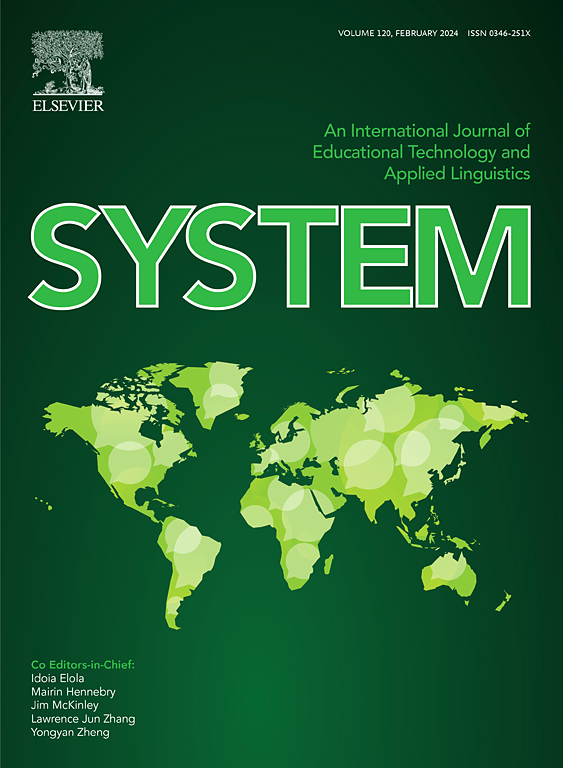Cognitive processing in simultaneous interpreting with synchronous captioning: An eye-tracking study of Chinese head-final noun phrases with varied dependency distances
IF 5.6
1区 文学
Q1 EDUCATION & EDUCATIONAL RESEARCH
引用次数: 0
Abstract
Grounded in the pedagogical goals of interpreting training, this study explores the impact of automatic speech recognition technology on cognitive processing in simultaneous interpreting, specifically, how trainee interpreters handle Chinese head-final noun phrases with varying dependency distances, i.e., how they navigate syntactic asymmetry between Chinese and English and capture information focus in simultaneous interpreting with synchronous captioning, with particular emphasis on the effects of highlighting head nouns and dependency distance variations. To examine these factors, an eye-tracking experiment involving 30 Chinese trainee interpreters was conducted, where participants interpreted a speech which contained 16 experimental sentences with controlled dependency distances in noun phrases featuring head nouns highlighted within the captions, in comparison with 16 control sentences without highlighted head nouns. Eye movements in the interpreting process and interpreting performances were analysed. The results indicate that head noun highlighting enhances cognitive processing and information completeness during simultaneous interpreting by facilitating deeper reprocessing and comprehension, particularly for sentences with longer dependency distances. The study reveals that highlighting head nouns lowers omission rates and encourages more structured interpreting output, like prepositional phrases or relative clauses, depending on the dependency distance. Without highlighting, interpreting output tends to be more flexible but less accurate due to incomplete information rendering. These findings underscore the potential of incorporating visual aids, such as head noun highlighting, into interpreter training programs to enhance accuracy and cognitive resource management.
同步字幕同声传译的认知加工:不同依赖距离的汉语头尾名词短语眼动追踪研究
基于口译培训的教学目标,本研究探讨了语音自动识别技术对同声传译认知加工的影响,具体而言,研究了口译学员如何处理不同依赖距离的汉语头尾名词短语,即在同步字幕同声传译中如何驾驭汉语和英语的句法不对称并捕捉信息焦点。特别强调了突出头名词和依赖距离变化的影响。为了研究这些因素,研究人员对30名中国培训口译员进行了一项眼球追踪实验,在实验中,参与者翻译了一篇演讲,其中包含16个实验句子,这些实验句子在名词短语中有标题名词,在标题中突出显示,与16个没有突出显示标题名词的控制句子相比。分析了口译过程中的眼球运动和口译表演。结果表明,在同声传译过程中,头名词的高光提示有助于加深再加工和理解,从而提高认知加工和信息完整性,尤其对于依赖距离较长的句子而言。研究表明,根据依赖距离的不同,突出头名词可以降低遗漏率,并鼓励更有条理的解释输出,比如介词短语或关系从句。如果不突出显示,解释输出往往更灵活,但由于信息呈现不完整,解释输出的准确性较低。这些发现强调了将视觉辅助工具(如标题名词突出)纳入口译培训计划以提高准确性和认知资源管理的潜力。
本文章由计算机程序翻译,如有差异,请以英文原文为准。
求助全文
约1分钟内获得全文
求助全文
来源期刊

System
Multiple-
CiteScore
8.80
自引率
8.30%
发文量
202
审稿时长
64 days
期刊介绍:
This international journal is devoted to the applications of educational technology and applied linguistics to problems of foreign language teaching and learning. Attention is paid to all languages and to problems associated with the study and teaching of English as a second or foreign language. The journal serves as a vehicle of expression for colleagues in developing countries. System prefers its contributors to provide articles which have a sound theoretical base with a visible practical application which can be generalized. The review section may take up works of a more theoretical nature to broaden the background.
 求助内容:
求助内容: 应助结果提醒方式:
应助结果提醒方式:


